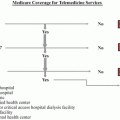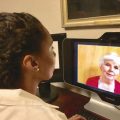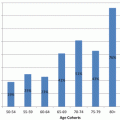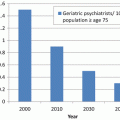© Springer International Publishing AG 2017
Shilpa Srinivasan, Juliet Glover and James G. Bouknight (eds.)Geriatric Telepsychiatry10.1007/978-3-319-51491-8_77. Scope of Telepsychiatry in Clinical Settings
(1)
Department of Neuropsychiatry and Behavioral Science, University of South Carolina School of Medicine, 3555 Harden Street Extension, Suite 301, Columbia, SC 29203, USA
Keywords
TelepsychiatryGeriatricsClinical settingsTrainingResearch7.1 Introduction
Mental disorders are a ubiquitous problem, with health systems around the world grappling to address the “Mental Health Gap ” created by growing numbers of mentally ill and extremely low numbers of mental health providers. Previous chapters in this book have described how, telepsychiatry has been shown to be a feasible alternative to effectively address the scarcity of mental health services. Mental health disorders are highly prevalent with epidemiological study estimates as high as 49% life time prevalence in the adult population [1]. The aging population across the world is on the rise. In 2006, almost 500 million people worldwide were 65 years of age and older. By 2030, that number is projected to increase to 1 billion or one in every eight of the world’s inhabitants, which is a 140% jump in developing countries by 2030 ([2]). This imposes social, economic, and medical challenges to our society at a time when geriatric medical care is not universally available. There is a dearth of geriatric medical and psychiatric practitioners. This dearth is further magnified in rural communities resulting in a significant individual and societal burden.
Telepsychiatry offers a unique delivery platform to be able to address some of these challenges by improving access, shortage of providers while reducing costs on several fronts including unwarranted hospital admissions, effective triage, and hand off to outpatient care via expert availability in real-time [3]. It becomes imperative for healthcare providers to become familiar with the challenges in the field of telepsychiatry given the insurmountable mental health gap . This can only be addressed by increasing the number of geriatric psychiatry fellowships, strengthening and growing existing ones, and increasing psychiatric training at the under-graduate level. While many of these solutions have lengthy gestation periods, technological solutions like telepsychiatry can attempt to address the impending problems of unmet needs, scarce resources, provider shortage, and the urban–rural and tertiary–primary care divide. A perfect marriage of technology and mental health services in many settings and more so in the geriatric setting can be the panacea to health care system and to the citizens we serve.
This chapter attempts to provide a comprehensive literature review that supports acceptable, reliable, and cost-effective application of telepsychiatry strategies in geriatrics. Telepsychiatry has proved useful in both clinical and nonclinical applications in geriatric medicine and psychiatry, in clinical care, distance learning, education, and research in various practice settings. Over the years synchronous and asynchronous telehealth has been used for consultation, diagnosis, management, psychotherapy, education, supervision of medical professionals in rural and outreach areas, as well as for research purposes [4]. Clinical care settings can be broadly categorized as hospital work to include emergency department, inpatient care and consultation liaison psychiatry, community work that includes chronic disease management and disability management, office practice, integrated clinics, nursing home visits, home visits, and care planning.
7.2 Inpatient and Emergency Room Management
Given the magnitude of mental illness in our communities, there is tremendous demand for geriatric care in clinical setting including inpatient, outpatient, and consultation liaison psychiatry. Consultation via telepsychiatry for hospital patients is becoming more acceptable in these settings and has been shown to improve clinical outcomes. Given the need for geriatric providers, it has been a focus of more recent telehealth efforts. Offsite consultation for nursing home residents has been reported by geriatric teams since consultation work is a major component of hospital geriatric practice [4, 5]. Evidence from other specialties including radiology, neurology, neurosurgery, geriatrics for effectively triaging admission using telehealth [6–8, 9] to nursing homes or inpatient beds has been reported, demonstrating that a larger proportion of patients can be managed without transfer- associated unnecessary costs. The likelihood of telepsychiatry use increases when the distances or potential for transfer is greater.
7.3 Emergency Evaluations
Telepsychiatry evaluations in emergency departments are offered across several programs in the United States of America (USA). These emergency evaluations require additional personnel both for physical control of the environment and for patient safety. Managing psychiatric emergencies including suicidal/homicidal patients, or those suffering from dementia, agitation or acute psychosis by using experts who can provide recommendation to the ED teams has been shown to promote cost-effectiveness, timely assessment, improvement in access to specialty and subspecialty services [10, 11]. In a study by Pallawala and Lun, telehealth services used to manage geriatric patients at a remote site led to rapid decision making in the presence of acute emergencies, reducing unnecessary admissions and improving nursing skills in geriatric care [8]. This study also demonstrated that telehealth can result in efficient management, while contributing to professional development for nurses. Telehealth helps converge experts where there are multi providers providing case management in complex chronic disease management models. This allows for clinical treatment plans that include expert advice and a well-rounded patient care experience for the patient.
Telehealth services can improve the quality of life for elders with physical and mental impairments. Other studies evaluating the effectiveness of home telemonitoring have demonstrated reduction in the number of hospitalization and emergency department visits of elderly patients with mixed chronic disease [12]. Another study of homebound elderly provided videophone nursing care to measure changes in their functioning and demonstrated it to be an effective and alternative care model that could be integrated into existing home-care services [13].
7.4 Nursing Home
Elderly in nursing homes, , especially in rural communities, are an underserved population, at greater risk of isolation and suicides. This risk is further magnified by under recognition and under diagnosis due to lack of specialized mental health services including provider access [14, 15]. Non-urgent consultations and advice from allied health practitioners have been reported from Australia where videoconference links to nursing homes were used [16]. The outcomes from five disciplines were reported in terms of user satisfaction and also adequacy of assessment. This enables clinical relationships between teams with clinicians from several disciplines working with hospital and nursing home staff resulting in enhanced clinical interaction and support for the nursing home and hospital staff. The geriatric provider can work closely with nursing staff to help provide specialty service, interact, educate, train, and support nurses who often have very little mental health training. Elders appear to benefit from telehealth services and seem to be more accepting and satisfied by technology driven solutions to address some of their healthcare needs [17, 18].
7.5 Therapeutic Applications of Telepsychiatry in Geriatric Ambulatory Care Settings
The practice of telepsychiatry in geriatrics is gaining popularity given the scarcity of geriatric psychiatrists. A consultative role that allows for clinical assessment and recommendation without ongoing management may be more practical to address the mental health gap given the enormous need and burden. There have been several studies and clinics that have successfully embedded specialists via telehealth. These studies have reported improved outcomes, cost, and patient satisfaction levels [19, 20]. Telepsychiatry is an effective tool that has been used in those with mild cognitive impairment and dementias while it may have less of a utility in those with severe dementia and sensory impairments. Standardized rating scales can be used via telehealth services both in clinical practice and research use of [21]. While a comprehensive geriatric assessment, including assessment of cognitive function would offer valuable information for treatment planning, severely impaired cognition may pose a risk for patients who are unfamiliar with technology and may need skilled staff to help navigate the healthcare delivery via telehealth [21].
Telepsychiatry can be used for ongoing psychotherapy sessions either between the clinician and patient from the comfort of their homes or in group sessions with the treating clinician and many participants [5].
Given the complexity of medical issues in the geriatric population and an emphasis on value-based care there is a need to manage chronic disease states in an efficient, integrated fashion that would help address the fragmentation that currently exists in the health care environment. This would provide improved satisfaction and health outcomes monitoring [22, 23] such as vital signs and blood glucose. These approaches could result in improvements in both physical and mental health parameters while resulting in cost-effective care and in chronic disease management. Video link to augment usual home care has been shown to be well accepted and cost-effective [24, 25], and can complement existing outreach and case management services.
Telepsychiatry has been utilized to deliver various modalities of psychotherapy including cognitive-behavior therapy , supportive therapy , group therapy for depression and anxiety disorders, and trauma focused therapy ([26, 27, 28]). Internet-based CBTs with online lessons and homework assignments have been conducted in patients with neurotic disorders [29, 30]. Neuropsychological assessments for cognitive evaluation and neurological tests such as abnormal involuntary movements have been carried out using telehealth [31, 32].
7.6 Education and Research
Telemedicine for distance learning purposes can occur between physicians, physician and patient, or physician trainee. It may also take place in a classroom setting where a preceptor is at one site and students are at other, multiple remote end user sites. It could be used for supervision, mentoring, continuing medical education programs for individuals within psychiatry, and across medical specialties [33]. A number of training programs across the nation include telepsychiatry experiences for residents in various clinical settings [34]. Supervision can occur in real-time with the supervisor present via videoconferencing, or by the use of store and forward technology (asynchronous transmission of clinical information).
Telemedicine particularly lends itself to procuring effective and reliable research data from clinical populations. It allows for remote acquisition of assessment information, direct observation, checking for inter-rater reliability, and scoring. It also allows for storing or archiving of data for later scoring and evaluation. This can occur in clinics, hospitals, nursing homes, home-based setting, schools, and forensic settings. Studies have demonstrated a high inter-rater reliability of the diagnostic assessment using telehealth [35, 36]. Telepsychiatry has been found to be a reliable alternative for diagnosis in geriatric population where studies [36, 37] found that subjective verbal reports were more reliable than visual observations when videoconferencing was compared to face-to-face evaluation of geriatric patients. A meta-analysis found that agreement between in-person assessment and high-bandwidth telepsychiatry evaluation was excellent while that of in-person with low-bandwidth telepsychiatric assessment showed adequate, but somewhat lower agreement than the former [38].
Studies have shown telepsychiatry to be a cost-effective delivery tool by minimizing travel time, reducing emergency room visits, hospitalization, time taken off from work [10, 39]. A number of factors need to be considered while determining cost-effectiveness, including health outcomes, utilization, accessibility, quality, and needs for such services in the specific population studied [40]. An increase in volume of telepsychiatry can bring down costs especially of capital investment at the beginning and of continued maintenance costs. Some studies have demonstrated that to get to a “break-even” cost analysis, an average of seven consultations per week are required [41, 42]. Many studies do not calculate the cost benefits for the individual, their families, referring physicians, and health systems. In forensic settings it appears that clinical and educational applications of telepsychiatry are cost-effective in minimizing unnecessary transfers and hospitalization in management of the cases [39, 43]. Butler et al. found a 10% reduction in cost for those who had telepsychiatry services compared to those who did not have it [44]. Further systematic studies are needed to evaluate the cost-effectiveness of telepsychiatry projects especially as it pertains to the elderly population.
Stay updated, free articles. Join our Telegram channel

Full access? Get Clinical Tree







